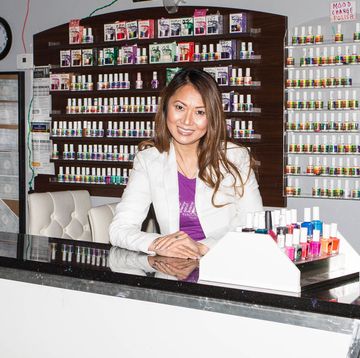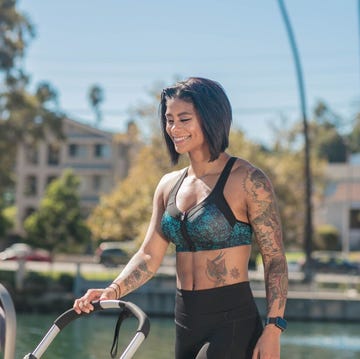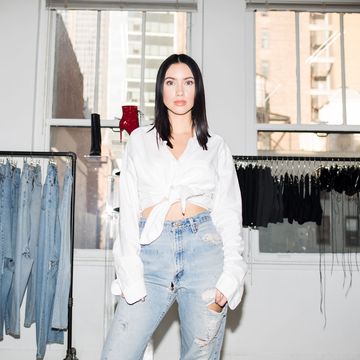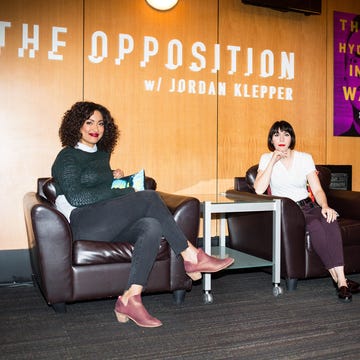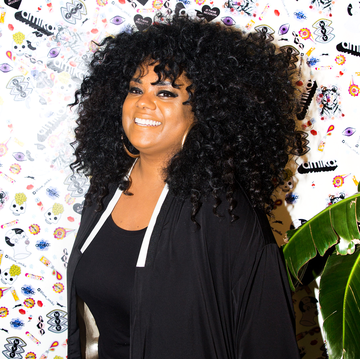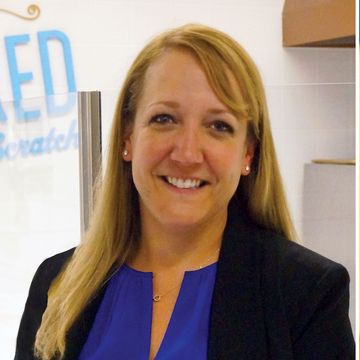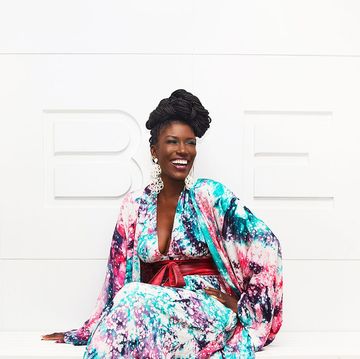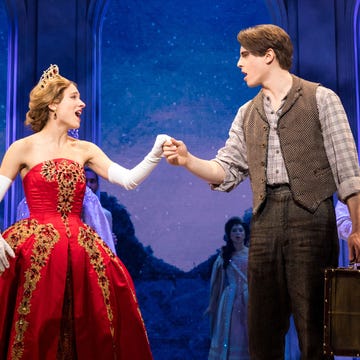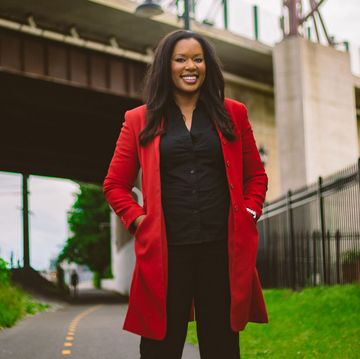Alicia Graf Mack became a professional ballerina at 17, had her face on the front of the Kennedy Center by 19, and thought her career was over at 21. She shares her story of bouncing back from catastrophic injury, living with arthritis as a dancer, and relentlessly following her dreams.
I was dancing out of the womb. Anytime I heard music, I would dance around the house. When I was about 2 years old, I was watching my mother practice aerobics and I started doing all of the moves with her. She thought it was odd that a toddler could pick up choreography. So she put me in dance class while I was still in diapers.
By the time I was 10 years old, I was taking class every day and on the weekends. I practiced ballet, modern, and jazz dance. I also trained at a classical school to supplement my ballet training. I knew I wanted to be a ballerina from as early as I can remember. It's pretty cool to have the same drive and passion for more than 30 years.
When I was 11, I was discovered by my coach, Donna Pidel. She was the founder of the Ballet Royale Institute of Maryland. She asked me, "Do you know what it takes to become a professional ballerina?" I said, "Sure?" Of course I didn't know, but I knew I wanted to do it. She trained me from the time I was 12 until I started dancing professionally at 17.
I went to a regular public high school, and I was dedicated to my academics. My mother is a professor at Howard University. There was no excuse for falling behind in school, even with my busy schedule. I would get up early to work out in the morning. Then I would go to school from 7:30 a.m. until 2 p.m. Then from 2 p.m. to 10 p.m. I would train in a group or private lessons. Somewhere in there was homework. And I would do it all again the next day.
I definitely didn't have a social life then. Holiday breaks were spent dancing. I spent my summers in competitive dance programs in New York City. But the thing is, I loved what I was doing so much that I don't feel like I missed out too much. My closest girlfriends were dancers too, so I had a close-knit group of friends who understood one another. We're still in touch to this day.
Toward the end of my junior year in high school, I told my parents that if I didn't get into a major dance company within a year, I would go to college. I took the SATs, but I was hoping to get a job. As a ballerina, you start very young. By the time you're 21, you should be well on your way in your career.
During my senior year of high school, one of my private teachers invited me up to New York City to take a class with the Dance Theatre of Harlem. Ballet companies will often hold open classes that you can take if you're invited. It's a way to get noticed by the company director without it being a formal audition.
The day I went up for class, the founder, Arthur Mitchell, was there. He is one of the biggest icons in dance, so it was a thrill just to be in the same room with him. After class, he pulled me aside and gave me some corrections, which are critiques on your style and technical ability. He said, "I think you're beautiful. Maybe you can come try our summer academy, and if we like you, perhaps there will be a spot in the junior company." I understand this was a wonderful offer, but I wasn't interested in a maybe. So I said to him, "Thank you very much, but I am not interested in any more pre-training. I am looking to join a company full-time." I assumed I'd never hear from him again.
A couple of weeks later, Dance Theatre of Harlem was in the D.C. area performing, and Mr. Mitchell was teaching a master class. He asked me to come in. During class I worked hard to show that I had been working on the corrections he had given me. The next day, while I was at school, he called my parents and offered me a position in the company as an apprentice, which is the entry-level job of a professional dancer.
I was 17, and it was the beginning of my senior year of high school. I moved to New York City for the job and finished my classes through correspondence with the Professional Children's School. My dad is a native New Yorker, so I had family there, which made the transition easier for me. I lived with my older cousins for three months, then moved into a college housing facility near Columbia University. By the time I turned 18, I moved into an apartment with a roommate.
The job of an apprentice dancer is sort of like an understudy. It's understood that you might not get to perform and that you're at the very bottom in terms of ranking. I got my job at a very fortunate time. There was a lot of work from new choreographers coming into the Dance Theatre of Harlem, and I had the chance to be seen by them. If a choreographer likes you, they put you in, regardless of your ranking in the company. From the moment I joined, I was performing. I was an apprentice for six months and then was promoted to a core member, which typically doesn't happen for at least a year. This opened up more opportunities for bigger roles, and I made a bit more money.
A dancer's work schedule is a little different, but it's a job like anything else. Typically you start your day at 10 a.m. for a two-hour company class, which is focused on conditioning, strength, and technique. I would arrive by 9 a.m. to stretch, study videos, or do some physical therapy. Then you rehearse from noon to 7 p.m. to learn and perfect new and old work. That's always Monday through Friday, and sometimes on Saturday. On performance day, you come in a little later, take class, rehearse, spend two hours in hair and makeup, eat something, warm up again, and be on stage by 8 p.m. You leave the theater by 11 p.m., go to bed, and do it again the next day.
When the company tours, it's a grueling life. The physicality of the job coupled with travel and injuries is hard to endure at times.
I've had a lot of injuries through my career. I find it a blessing and a curse. I have a very flexible body, which is wonderful for dance, but it makes my body more unstable and susceptible to injury. I've had three knee surgeries, one foot surgery, and a back surgery. I'm sort of the bionic woman at this point. I also have ankylosing spondylitis (AS), a debilitating form of arthritis. I've had it since I was very young, but it didn't flare up until I was into my career.
I was 19, being recognized in the dance world, getting amazing reviews in The New York Times, and people knew who I was around the world. But I had swelling in my knee from time to time. It blew up to the size of a grapefruit. Every time I went to a doctor, he would just drain it and send me back to work. It took a year to get a diagnosis of AS. By this point I needed surgery in my knee.
During recovery, it got worse and worse. It showed up in my hips and ankles. I couldn't rehab from my surgery, and I certainly couldn't dance. I was 19, broke, and really depressed. It took more than a year for my body to heal, and that's a really long time to not be training as a dancer. I was afraid to start dancing again so I decided to start a new life. I quit Dance Theatre of Harlem, where I was still a member during my medical leave, and I enrolled at Columbia University and graduated with a history degree in three years.
I had no idea what I wanted to do, but I knew I loved to read and I knew I was a decent writer. During school I had an internship at JP Morgan in the marketing department. I helped with branding and advertising, but where I found my home was in sponsorship and philanthropic giving. Many of the firms the bank works with gave a lot to arts organizations and arts education. That was right up my alley. I was extended a full-time offer upon graduation, and I accepted it. I graduated in May, and I was supposed to start my new job on Wall Street in September.
But during my last year there, I started moving a little more. I joined the dance club on campus and took some open modern dance classes at downtown studios, away from the professional ballet world. I wanted a low-key environment where I wouldn't feel judged. As luck would have it, one of my teachers was also a teacher for the Alvin Ailey American Dance Theater.
He saw me in class and asked if I thought about a career in dance. I was like, "Been there, done that, I'm just here to have a good time." But he did persuade me to come see a performance and meet the artistic director, Judith Jamison. She was one of my idols, so I agreed. She was very kind, and we kept in touch. After that experience, I wanted the feeling of being around a dance company again, even if I wasn't going to be in it. So I contacted a company called Complexions Contemporary Balletin New York. I asked if I could be a marketing intern during the summer before I started my Wall Street job. They asked if I would instead join them as a dancer on their Italian tour over the summer. I thought, Italy? Sure! So I went on tour with them and fell back in love with dancing. By this time it had been four years since I quit dancing. My injuries had healed, and I felt strong.
When I returned from that tour, Carmen de Lavallade came to the Complexions studio and watched us rehearse. She is a dance icon and one of my idols. She pulled me aside and asked, "What are you doing with your life?" I said, "I start work at JP Morgan in a week." She told me, "Anyone in the world can be a banker. Very few people have the talent that you have, and I think you should make a different plan for your life." She wasn't offering me a job, but when someone like Carmen de Lavallade says that to you, it means something. I called JP Morgan and told them I had to decline the job. They were so encouraging for me to follow my dreams, but I did have to give the signing bonus back.
I returned to the Dance Theatre of Harlem and had the best dancing year of my life. I felt confident, strong, and thrilled to have this second chance at my dream. Then, in 2004, the company disbanded and closed. It was heartbreaking.
I worked with Complexions again for about a year and then had the chance to audition for Alvin Ailey. It was a huge open call audition for one position. More than 200 people showed up, and only one person gets the job. I got the job.
I started in the summer of 2005. It was a hard transition from ballet to modern dance. The latter is very athletic, and the schedule was extremely rigorous. But I loved every moment. I danced with the company for three years. We traveled the world, and it felt like the height of my career.
Then my arthritis came back. It was in my eyes, my knees, and my spine. I had blurred vision, and I got another tear in my knee. I was almost 30, and I thought, This is it. I will never dance again. Part of being a dancer is giving your joy and happiness to an audience, but if you're in constant pain, it's very hard to fake that.
With tears in my eyes, I told Ailey that I was taking a break. I moved to St. Louis, went back to school to get my master's in nonprofit management at Washington University, and got married. In the evenings I taught ballet at Webster University, and they offered me a tenured position after I graduated.
I didn't know teaching would be so intense. I needed to take classes to warm my body for my lessons. Being in the studio again every day, the bug hit me again. My body felt good. And then word got out that "Alicia is dancing again." The dance world is a very small world.
In 2011, the associate artistic director of Ailey asked me to perform for Judith Jamison's retirement celebration. I thought that was the scariest thing ever, but I wanted to do it. She had done so much for me. The performance felt great, and I gave in again: I am a dancer. It's what I do.
After the performance, the company asked me back, and I've been a part of it ever since. I had another major injury in March that sent me to surgery again. I had a herniated disc in my lower lumbar. I knew the recovery would be long and painful. But I had been here before. I know I'll be back onstage. In the meantime, I get to spend more time with my husband in St. Louis. We are expecting our first child.
I also started a dance workshop called D(n)A Arts with my sister, Daisha, who is also a dancer. We host workshops and training camps in New York City for young, aspiring dancers. We teach classes and recruit well-known dancers and choreographers from various genres of dance to teach and speak to the kids. In 2015, we will have our first tour, which will visit D.C., Chicago, New York, and St. Louis. The only piece of advice I can give an aspiring dancer is to follow their passion. Witnessing that passion ignite in so many young dancers inspires me.
As my body is healing and creating life, I have so many things to look forward to. I am determined to dance for my entire life. When you really love something, it stays in your heart. I will be a 90-year-old woman, and I will be dancing.
Get That Life is a weekly series that reveals how successful, talented, creative women got to where they are now. Check back each Monday for the latest interview.
Follow Heather on Twitter.



